Osculum Study guides, Class notes & Summaries
Looking for the best study guides, study notes and summaries about Osculum? On this page you'll find 51 study documents about Osculum.
Page 4 out of 51 results
Sort by

-
Abeka - Biology: God's Living Creation Test 11 (Revised) Questions and Answers 100% Pass
- Exam (elaborations) • 6 pages • 2024
-
- $11.49
- + learn more
Abeka - Biology: God's Living Creation Test 11 (Revised) Questions and Answers 100% Pass What group includes snails, slugs, conchs, and nudibrancks? - Correct Answer ️️ - Gastropods What sessile animals are characterized by spicules, incurrent pores, an osculum, and no nervous system? - Correct Answer ️️ -Sponges What molecules make up the cell membrane? - Correct Answer ️️ -Phospholipids In what process does a cell engulf a solid particle by surrounding it with the cell me...
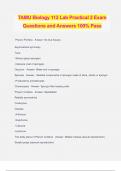
-
TAMU Biology 112 Lab Practical 2 Exam Questions and Answers 100% Pass
- Exam (elaborations) • 23 pages • 2024
-
- $12.49
- + learn more
TAMU Biology 112 Lab Practical 2 Exam Questions and Answers 100% Pass Phylum Porifera - Answer- No true tissues Asymmetrical symmetry Taxa: -Silicea (glass sponges) -Calcarea (rest of sponges) Osculum - Answer- Water exit in sponges Spicules - Answer- -Skeletal components of sponges made of silica, calcite or spongin -Produced by amoebocytes Choanocytes - Answer- Spong's filter-feeding cells Phylum Cnidaria - Answer- Diploblastic Radially symmetrical Cnidocytes Classes: -Anthozoa...
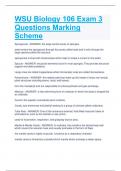
-
WSU Biology 106 Exam 3 Questions Marking Scheme
- Exam (elaborations) • 18 pages • 2024
- Available in package deal
-
- $11.99
- + learn more
WSU Biology 106 Exam 3 Questions Marking Scheme Spongocoel - ANSWER- the large central cavity of sponges. water enters the spongocoel through tiny pores called ostia and it exits through the large opening called the osculum. spongocoel is lined with choanocytes which help to create a current in the water. Spicule - ANSWER- structural elements found in most sponges. They provide structural support and deter predators. Large ones are called megascleres while microscopic ones are called mi...
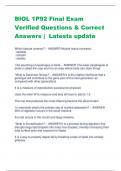
-
BIOL 1P92 Final Exam Verified Questions & Correct Answers | Latests update
- Exam (elaborations) • 18 pages • 2023
- Available in package deal
-
- $13.49
- + learn more
BIOL 1P92 Final Exam Verified Questions & Correct Answers | Latests update Which tissues contract? - ANSWER Muscle tissue contracts: - skeletal - smooth - cardiac Out-pouching of esophagus in birds - ANSWER The lower esophageal of birds is called the crop and it is an area where birds can store things What is Darwinian fitness? - ANSWER It is the relative likelihood that a genotype will contribute to the gene pool of the next generation as compared with other generations It is ...
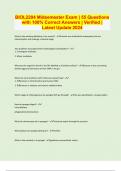
-
BIOL2204 Midsemester Exam | 55 Questions with 100% Correct Answers | Verified | Latest Update 2024
- Exam (elaborations) • 7 pages • 2024
- Available in package deal
-
- $7.99
- + learn more
What is the working definition of an animal? - Animals are multicellular eukaryotes that are heterotrophic and undergo a blastula stage Two problems associated with morphological classification? - 1. Convergent evolution 2. Minor mutations Why was the organism found in the 90s labelled as a bivalve mollusc? - Because it was consuming bivalve eggs and had traces of their DNA in its gut. What are some problems with molecular sequencing? - 1. Differences in mitochondrial and nuclear DNA ...
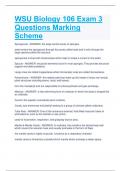
-
WSU Biology 106 Exam 3 Questions Marking Scheme
- Exam (elaborations) • 18 pages • 2023
- Available in package deal
-
- $13.09
- + learn more
WSU Biology 106 Exam 3 Questions Marking Scheme Spongocoel - ANSWER- the large central cavity of sponges. water enters the spongocoel through tiny pores called ostia and it exits through the large opening called the osculum. spongocoel is lined with choanocytes which help to create a current in the water. Spicule - ANSWER- structural elements found in most sponges. They provide structural support and deter predators. Large ones are called megascleres while microscopic ones are called ...
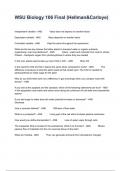
-
WSU Biology 106 Final (Hellman&Carloye) Questions With Correct Solutions
- Exam (elaborations) • 24 pages • 2024
-
- $12.89
- + learn more
WSU Biology 106 Final (Hellman&Carloye) Independent variable - ANS Value does not depend on another factor Dependent variable - ANS Value depends on another factor Controlled variable - ANS Kept the same throughout the experiment What are the two key tissues that allow plants to transport water or organic nutrients, respectively, over long distances? - ANS Xylem - water and minerals from roots to shoots Phloem - transports sugars from ...
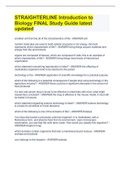
-
STRAIGHTERLINE Introduction to Biology FINAL Study Guide latest updated
- Exam (elaborations) • 23 pages • 2022
-
- $10.39
- + learn more
smallest unit that has all of the characteristics of life - ANSWER-cell nutrient molecules are used to build cellular structures or for energy. this best represents which characteristic of life? - ANSWER-living things acquire materials and energy from the environment organs are composed of tissues, which are composed of cells. this is an example of which characteristic of life? - ANSWER-living things have levels of hierarchical organization which statement concerning reproduction is fal...

-
NURSING ZOOLOGY LESSON 8-13 (A+) STUDY NOTE
- Class notes • 51 pages • 2023
-
- $15.49
- + learn more
8.1. Phylum Porifera (the sponges) Most sponges live in shallow ocean waters, although a few are fresh water. Adult sponges are sessile and live attached to the bottom of clear water. Their bodies are simple, vase-shaped with a central cavity opening (osculum) at the top (Fig. 9.1). Sponges have no organs. Not even a digestive system. They have no coelom. They have cells aggregated into water canal systems. Water moves through the tube-like cells into the spongocoel, then out through the o...
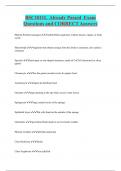
-
BSC1011L Already Passed Exam Questions and CORRECT Answers
- Exam (elaborations) • 15 pages • 2024
-
- $9.99
- + learn more
Phylum Porifera (sponges) multicellular organisms without tissues, organs, or body cavity Heterotroph organism that obtains energy from the foods it consumes; also called a consumer Spicules hard spear or star-shaped structures; made of CaCO3 (limestone) or silica (glass) Choanocyte line the gastrovascular cavity & capture food Amoebocyte digest & distribute food Osculum large opening at the top where excess water leaves Spongocoel large central cavity of the sponge

Did you know that on average a seller on Stuvia earns $82 per month selling study resources? Hmm, hint, hint. Discover all about earning on Stuvia


